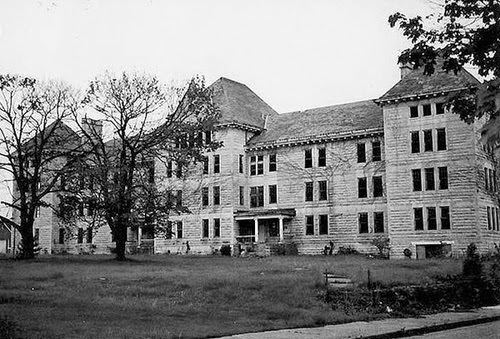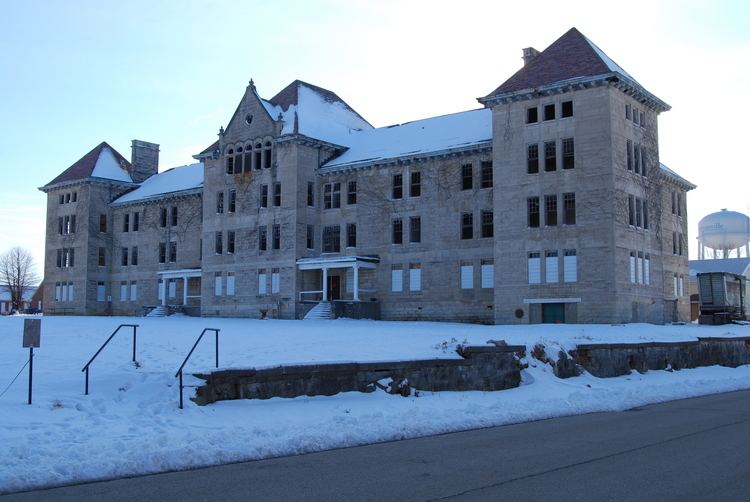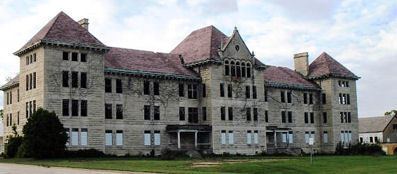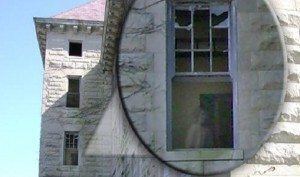NRHP Reference # 82002590 Added to NRHP 17 February 1982 | Area 87 ha | |
 | ||
Location Ricketts Ave. and U.S. 24, Bartonville, Illinois Built 1895-1910; 1902 (opened) Architectural styles Prairie School, Mission Revival architecture, Georgian architecture, Neoclassical architecture Similar Manteno State Hospital, Hotel Kaskaskia, Mercer County Courthouse, Ambrose Hall, Hodges House | ||
Peoria state hospital illinois asylum for the incurable insane
Peoria State Hospital Historic District, also known as Bartonville State Hospital or Illinois Asylum for the Incurable Insane, was a psychiatric hospital operated by the State of Illinois from 1902 to 1973. The hospital is located in Bartonville, Illinois, near the city of Peoria in Peoria County. The hospital grounds and its 47 buildings are listed as a historic district on the National Register of Historic Places.
Contents
- Peoria state hospital illinois asylum for the incurable insane
- Peoria ill message for police dept
- History
- Architecture
- Ghost stories
- References

Peoria ill message for police dept
History
The hospital was founded as a result of the Illinois General Assembly's provision for the establishment of the Illinois Asylum for the Incurable Insane in 1895. In response to the legislation, then Governor [[Johnselection. The commission president was John Finely, a Peorian, and one of the members was J.J. McAndrews of Chicago who later served in the U.S. House of Representatives as a Congressman. The commission selected the site near Peoria, in Bartonville.

Construction at the site started in 1895 with the main building completed in 1897. This building was never used, however, as its structural integrity was compromised by abandoned mine shafts on the property. The 1927 history of the hospital, however, gives a different explanation for its abandonment:

In 1902, reconstruction was completed under the direction of Dr. George Zeller as a cottage system plan of 33 buildings . Among the buildings were patient and caretaker housing, a store, a power station, and a communal utility building.

The Illinois Hospital for the Incurable Insane began operations on February 10, 1902 and patients characterized as "incurable" were transferred to Bartonville from other Illinois facilities. In 1906 the hospital opened a training school for nurses. From 1907 to 1909 the facility was known as the Illinois General Hospital for the Insane and, in 1909, Peoria State Hospital. This same year, the offices of Board of Commissioners and Board of State Commissioners of Public Charities were abolished and all state-run charitable institutions were administered by the Board of Administration.

On the hospital's 25th anniversary in 1927, the population was 2,650 with a total of 13,510 patients having entered the facility. During this time, Dr. Zeller was widely respected for his focus on therepeutic efforts. Zeller crusaded for a better public understanding of the mentally ill including inviting newspaper reporters and community members to visit Peoria State. From 1943 until 1969 the hospital participated in a departmental affiliation program for psychiatric nursing which provided instruction in psychiatric nursing to students from regional general hospital nursing schools.
From 1917 until 1961 the hospital was operated by the Illinois Department of Public Welfare. In 1961 the Department of Mental Health was created and assumed responsibility of the institution.
At its peak in the 1950s, Bartonville housed 2,800 patients. By 1972 when its closure was announced, the patient census had dropped to 600. After the hospital closed, the buildings stood empty and were auctioned off. When the initial auction buyer went bankrupt, developer, Winsley Durand, Jr., took over ownership with the hope of creating office space in the structures. His plan was never fully realized and the buildings remained empty. Since that time, many of the remaining structures have been demolished and others were renovated to house various commercial and industrial businesses. The Village of Bartonville has established the entire property as a TIF district to encourage further growth and development of the property.
The Bowen, or administration, building is currently under the ownership of the "Save the Bowen Foundation," a group that sought to raise funds to renovate the exterior of the building. Richard Weiss is the Executive Director of the Save The Bowen group that wanted to help save the historical property that is part of the Peoria State Hospital Historic District. The Save the Bowen Foundation looked for investors to partner with the restoration of this building, but was unable to secure sufficient funding.
After 8 years of trying to save the Bowen, Richard Weiss has entered an agreement with the Village of Bartonville to demolish the building and salvage parts to relieve his $750,000 debt. Demolition was scheduled to start 1 March 2016 and must be completed by 1 January 2017.
Richard Weiss can be contacted through the peoria-asylum.com website.
Architecture
The grounds consists of 63 buildings, many of which are residential in nature and laid out to the traditional cottage plan, common for mental hospitals built in the early 20th century. The original main building constructed was on the Kirkbride Plan.
Ghost stories
The hospital grounds are the subject of local ghost lore. One well documented legend tells of Manuel A. Bookbinder "Old Book", a patient who worked with the burial crew at the hospital until his own death. It is said that upon his death his physical form was seen by Dr. Zeller and over a hundred of the patients and nurses that attended his funeral crying at the old elm in the potters field. A closer inspection of the casket for which he rested showed the peaceful remains of the loved figure still resting within, thus the legend of the "Graveyard Elm" began.
In the 1920s, Zeller penned a book titled, Befriending The Bereft, drawn from the mysterious experiences he had at the hospital during his two tenures as superintendent, 1902–1913 and 1921–1935. Included, among numerous other eerie stories, were Zeller's own account of Old Book and the Graveyard Elm.
